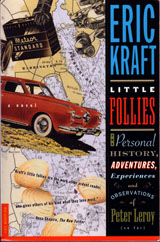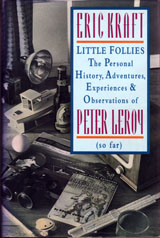

| Little Follies
Do Clams Bite? Chapter 11: On the Techniques and Equipment Necessary for Clamming |
by Eric
Kraft, as Peter
Leroy
|

YOU CAN READ THE FIRST HALF
YOU CAN ORDER THE
|
The professional, the clammy, took to the bay in a broad-beamed clamboat. Some of the newer ones had been built in basements or back yards specifically for motorized clamming. They were, as a group, homely and unpretentious craft, roughly rectangular, rising slightly at the bow. Placed near the stern was a small cabin, just large enough to allow the clammy to get out of the sun or the rain for a while, to eat his lunch and drink his beer. Others were converted sailing craft, relics of the days when men were men and clamboats had no motors. These broad-beamed, shallow-draft boats had had their masts and centerboards removed, and now had engines. A few clamboats of both types had engines that were specifically designed for marine use, but most had marine conversions of engines from worn-out cars. Typically, the engine would simply be dropped into the hull, transmission and all. The exhaust was routed upward through a straight stack alongside the cabin, and a galvanized bucket, the same bucket that was used for washing down the deck at the end of the day, was inverted on this stack when the boat was idle, to keep rainwater out. The driveshaft went to a prop, and only first gear and reverse were used. The radiator was eliminated, and bay water was circulated through the block for cooling. Since all clamboats leak, the savvy clammy also made a provision for drawing bilge water through the block and emptying it into the bay, so that the engine bailed the boat while it cooled itself. A simple hand valve switched between bay water and bilge water. I have known many clamboats, and owned a couple, in which this valve was left permanently in the bailing position. All clamboats had wide, unobstructed decks that ran all around the perimeter of the boat. The clammy would stand on this deck and lower a pair of tongs or, in the technical vocabulary of the profession, sticks, into the water. These sticks could be had in lengths ranging from eight to twelve feet or so. Their long wooden handles were pivoted near the bottom end. At the bottom of each stick was a sturdy wire basket, and at the very bottom of each basket was a row of sturdy metal fingers or teeth. The clammy worked the handles back and forth, raising and dropping the sticks, opening and closing the basket. Each bite scooped up some sand or muck, shell, weed, and, if the clammy had picked the right spot, clams. By shaking the closed baskets vertically, the clammy could wash out the sand and weeds before raising the closed sticks hand over hand, bringing up the catch and dumping it on the deck. The clammy would then take a step to the left, or right if that was his habit, and begin again, so that he would gradually work his way around the deck and, aided by the slow shifting of the boat in the wind and current, cover a broad section of the bottom pretty well by the time he returned to his starting point. This sounds simple enough, but the subtleties of the art took years to master. Let me give you a single example. A really good clammy could tell just what was in the basket as he shook out the sand and weed. When I was small, I thought that they got their information by weight or sound or vibrations through the sticks. After I had done some clamming myself and spent some time with real master clammies, I learned that a clammy, working his sticks open and shut, rocking swaybacked in the hot sun hour after hour, standing with his feet apart, shifting his weight constantly on a rolling deck, squinting into the sunlight rippling on the waves, attains an exalted state of awareness that allows him to see what is in the basket at the bottom of the bay, and that the best of them can not only drop the shells out, but even let the big, tough chowder clams go and keep the small, sweet, valuable cherrystones and littlenecks. Tonging for clams was hard work, tiring work. Much less tiring, and much more fun, was treading for clams. The tonging clammy worked in the deeper parts of the bay, but the treader worked in the flats, standing in water that was about waist deep. Treading took less skill than tonging; all the treader did was walk around, on the balls of his feet, feeling for clams with the toes and the ball of the foot itself. When he found one, he would duck beneath the surface and pull the clam out of the sand by hand. For treaders with experienced feet, judging the sizes of the clams they found was an easy matter. The casual treader, just gathering a few hors d’oeuvres to have with the evening cocktails, might pass up the larger clams completely, but people who treaded seriously, and there were quite a few, would harvest everything. All serious treaders, and many casual treaders, put the clams they caught into a peck basket that they had inserted into the open center of an inflated inner tube. With this container floating handily beside them, they didn’t have to make frequent trips to the boat to empty the catch. My grandfather disdained this eminently sensible contraption. Serious treaders would spend all day at the hunt, so they had to protect their feet in some way. Most used extremely unattractive gray rubber booties. Both tonging and treading required the clammy to actually go out on the bay in pursuit of the clams, but at the time of my clamming trips with Grandfather, a few visionaries were already experimenting with a new method: avoiding going out on the bay entirely and raising clams at home. Since that time, the popularity of home clam farming, in tanks built especially for that purpose, in swimming pools, or even, on a small scale, in discarded bathtubs, has increased enormously. The main reason, as Porky White put it once, is that “There’s no size limit on home-growns. You can gorge yourself on tender little darlings if you want.” |
 |
||||
| ..... | .......... | .......... | ..... |

Here are a couple of swell ideas from Eric Kraft's vivacious publicist, Candi Lee Manning: Tip the author.
Add yourself to our e-mailing list.
|
Little Follies is a work of fiction. The characters, incidents, dialogues, settings, and businesses portrayed in it are products of the author’s imagination and are not to be construed as real. Any resemblance to actual events or persons, living or dead, is entirely coincidental. All rights reserved. No part of this book may be reproduced or transmitted in any form or by any means, electronic or mechanical, including photocopying, recording, or by any information storage and retrieval system, without permission in writing from the author. “My Mother Takes a Tumble,” “Do Clams Bite?,” “Life on the Bolotomy,” “The Static of the Spheres,” “The Fox and the Clam,” “The Girl with the White Fur Muff,” “Take the Long Way Home,” and “Call Me Larry” were originally published in paperback by Apple-Wood Books. Little Follies was first published in hardcover by Crown Publishers, Inc., 201 East 50th Street, New York, New York 10022. Member of the Crown Publishing Group. YOU CAN ORDER THE
For information about publication rights outside the U. S. A., audio rights, serial rights, screen rights, and so on, e-mail the author’s imaginary agent, Alec “Nick” Rafter. The illustration at the top of the page is an adaptation of an illustration by Stewart Rouse that first appeared on the cover of the August 1931 issue of Modern Mechanics and Inventions. The boy at the controls of the aerocycle doesn’t particularly resemble Peter Leroy—except, perhaps, for the smile. |
|
||||||
| . | . |